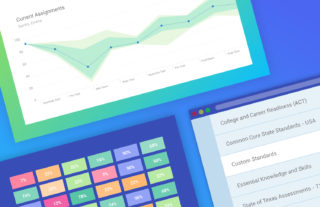What is a Professional Learning Community (PLC)?


Being a teacher can sometimes feel like living a paradox. The work is simultaneously rewarding and draining. Kids fill your classrooms, their energy is contagious, and the relationships you build are heartwarming. At the same time, the work can be isolating: You can feel cocooned in your classroom, overwhelmed, without sufficient space and time to reflect and to learn with your colleagues.

Over the past decade, Professional Learning Communities (PLCs) have become a popular structure for teachers to reflect, collaborate, and learn in order to meet the learning needs of their students. But because of this popularity, PLCs are sometimes ill defined, diluting their power and effectiveness. When educators understand the key components of a PLC, however, they galvanize professional learning, improve instruction, and lead students to learn more and more deeply.
What is a Professional Learning Community?
Professional Learning Communities are small groups of educators — usually classroom teachers and learning specialists — who meet regularly, conduct cycles of inquiry, look at student work, and commit themselves to continuous improvement. Instead of “top-down” professional development, organized by a principal or district leader, PLCs believe that educators learn best when their attention is connected directly to their students’ outcomes. When educators develop trust with each other, and they see that their collaboration leads to better student learning, they build collective efficacy and a desire to improve even more.
What are the components of a PLC?
In “What Is A Professional Learning Community,” Richard DuFour outlines three critical components that distinguish a PLC from other groupings.
1. PLCs focus on what students learn, not what teachers teach.
The aim of a PLC is not to ensure that students are taught but to ensure that students learn. Put another way, the goal of a PLC is not to make the teacher look better in the classroom when they’re observed. Rather, the core of a PLC is about what students learn and are able to do. As a result, teachers in a PLC ask the following three questions:
- What do we want each student to learn?
- How will we know when each student has learned it?
- How will we respond when a student experiences difficulty in learning?
These questions mirror the three stages of backward planning of Understanding By Design (McTighe and Wiggins) and support teachers to stay focused on their ultimate goal.
2. PLCs focus on a culture of collaboration.
The best learning and the best results cannot occur in a vacuum. In their separate classrooms, teachers do amazing things with their students every day, but their efforts may get diluted unless their colleagues follow suit and also employ the same best practices. In PLCs, educators collaborate to determine which instructional moves make the most impact with their students. When working in tandem, teachers see that their hard work accelerates the learning of their students, which builds momentum to want to do more. This positive feedback loop, also called collective efficacy, is an important component of PLCs.
3. PLCs focus on results.
Perhaps the most important component of a PLC is its focus on student learning results. The goal is not to improve teachers’ perception in the classrooms by outside observers. It’s not to make students like them more or to encourage parents to send positive emails. The ultimate aim of a PLC is to drive student learning outcomes. By looking at data and student work, PLCs analyze what’s working and what’s not. Adopting the principles of Improvement Science, PLCs keep student data at the center, not trying “by gut” or “by feel.” What works for students works for members of the PLC.
Types of Professional Learning Communities
There are no hard and fast rules about how PLCs should be configured, except that they should remain small, if possible, and include educators directly connected to students. In other words, school leaders are generally not part of PLCs. Here are three ways that schools can organize their PLCs:
- by grade level
- by course
- by department
Instead of forming PLCs by what makes sense to adults, it’s preferable to consider the groupings that will lead to the best student results. Different schools have different goals, so it makes sense to align PLCs with a school’s theory of action.
What makes for an effective Professional Learning Community?
In addition to making sure that your PLCs include the three key components listed above, the strongest PLCs tend to share similar practices and values. In “Create a Vibrant Learning Culture,” Brian Edwards and Jessica Gammell offer several ingredients that make for an effective PLC. Among them are:
- Taking the Time. For PLCs to work at their highest potential, educators need regular, sufficient, uninterrupted time to gather, look at student work, analyze data, decide on instructional strategies, affirm their successes, and throw out what doesn’t work. When meetings are infrequent, sporadic, or challenged by other competing demands, the possibility for collective efficacy decreases.
- Building Trust. The best PLCs invest in team building not only when forming their group but as an ongoing practice at every single meeting. As Anthony Bryk and Barbara Schneider emphasize in “Trust in Schools,” adults develop trust with each other over time, and trust remains one of the most important drivers of collective efficacy and better student results.
- Focusing on Multiple Forms of Student Data. Effective PLCs understand that their decisions should emerge from student learning data. But the best PLCs consider multiple forms of data — formative and summative, emerging from a range of vantage points — in order to best serve their students. Shane Safir’s work on the merits of “street data,” in addition to “satellite” and “map” data, reminds educators to follow the voices and experiences of the most marginalized and most vulnerable students.
- Stepping back to reflect. Although PLCs have a bias toward action, it is crucial that educators incorporate regular reflection into their cycles of inquiry. Without time to take stock of what they’re learning, and the impact that they’re having, teachers may find themselves bouncing from one instructional move to the next. Reflection offers a space for not only individual teachers but also the entire PLC to celebrate successes and growth.
Educator collaboration leads to strong student results.
For a long time, educators have considered how best to organize adult professional learning that leads to strong student learning results. Large amounts of money have gone to outside providers, when the research indicates that educators, working together in small Professional Learning Communities, and putting students at the center, have the answers right in front of them. James Bowie High School, for example, is an excellent case study on the power of putting PLCs into practice.




